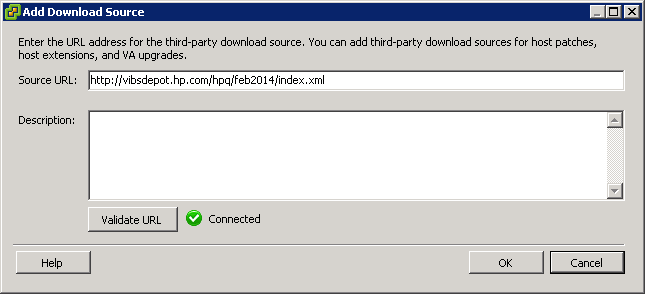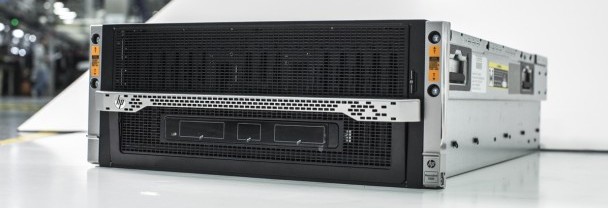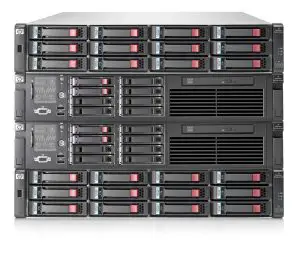This morning, HP CEO Meg Whitman unwrapped a new generation of HP’s ProLiant servers and unpacked the company’s compute strategy the years ahead. HP first introduced the server to the world 25 years ago and in celebration of that milestone, HP is looking forward to the 25 years to come. The strategy is wrapped around a focus on customer outcomes rather than the incremental tick and tock of hardware.
HP is responding to the increasing pressure being put onto IT shops due to the increase of data, data devices, apps and connections. In its research, the growth curve of incremental change in server hardware and the curve of requirements for IT shops simply don’t match. Incremental change won’t allow business to keep up with the increasing needs based on time, power or space. So the focus for the future from HP is to orchestrate and reduce the manual steps required for administrators to accomplish their work.

HP see the future of compute as an increasing amount of pooling for resources, dynamically re-alloacting and re-tasking resources based on changing needs throughout the day. HP Helion and OpenStack will play a major role in the transformation of the future of compute. Traditional applications just can’t meet business needs.
I had the chance to talk with Peter Evans, vice president of HP Servers Global Marketing, this morning and he told me that the ProLiant Gen9 hardware has a strong focus on increasing the performance per dollar, kilowatt and square foot. HP has spent a lot of time working to reduce the number of manual processes and clicks that are required to perform the tasks that consume a lot of practitioner’s time.
While HP is talking about their vision for the next 25 years of compute, they’ve been delivering on this vision for the past 2 year with ProLiant Gen8. A lot of the innovation that went into Gen8 aligns with the focus that HP has with this strategy. HP has collected and aggregated data that it gleaned from the Insight Online data and diagnostics information, information provided back by their partners and based on the experiences of their professional services organization and system engineers. All of this feedback and data has gone into the prioritization and decision making of what features get the precious attention of HP development cycles. The focus is more focused customer outcomes and not just on the technology.
Evans unpacked 3 metrics of focus that HP is delivering with the Gen9 announcement. The first is economics of the datacenter. ProLiant Gen9 offers customers a 3x improvement in performance. HP has performed comparative studies against its own G6, G7 and Gen8 systems as well as competitor’s servers. The second area is time to service. It is all about optimizing the number of clicks and amount of time before customer are able to begin using a solution on the ProLiant server. In some cases, Evans says that HP has reduced the number of clicks required from 480 to just 4 using iLO, OneView, Intelligent Provisioning and other methods. The last is value of service. In that, HP is focused on providing the best possible experiences for running particular applications, enabling better density and more productivity for its customers.
ProLiant Gen9 Enhancements
Among the new features are enhancements to the iLO including iLO Federation, UEFI BIOS, updates to the Intelligent Provisioning and improvements to SmartCache, array controllers and drives supported.
iLO gets an upgrade by adding a redesigned API interface with OneView integration in mind. iLO will have a fully compliant RESTful API that OneView can use for orchestration. OneView will also make use of the new iLO Federation feature that debuts with the Gen9 systems. Althought new with Gen9 servers, iLO Federation is also available to Gen8 systems.
iLO Federation takes the standard iLO4 and allows it to multicast at boot and join other iLO on the network. From there, administrators can form groups of servers to aid in management from the iLO. The iLO Federation enables a new cascading firmware deployment method rather than sequentially and the ability to change and push settings across multiple systems easily versus making the changes 1 system at a time.
UEFI BIOS is another new feature for the Gen9 hardware. Unified Extensible Firmware Interface (UEFI) is the extension of EFI firmware that Intel originally developed for Itanium processors back in the 90’s. UEFI replace EFI and is a standard for low-level software between the OS and the hardware. It is meant to replace BIOS, which has limitations. UEFI is programmable, allowing OEM’s like HP to put additional software in this low-level operating system. UEFI allows HP to implement a new Secure Boot technology, though the specifics weren’t fully disclosed.
Intelligent Provisioning 2.0 will debut in the Gen9 hardware and will feature acceleration features aimed to get the server deployed and running a workload in less time and with less clicks. One of the tidbits I heard from the StoreVirtual team is that the new Intelligent Provisioning 2.0 will include the ability to deploy a StoreVirtual VSA easily. Intelligent Provisioning will go out and retrieve the latest version of the StoreVirtual VSA and deploy it onto the hardware with minimal interaction required. In addition, HP has been giving away free 1TB StoreVirtual VSA licenses with new server purchases all throughout the Gen8 line and is likely to continue [I did not confirm], making this a free and easy SAN to deploy.
In terms of workload acceleration, HP has extended support for 12 Gb/s SAS Expander cards and 12 Gb/s Smart Array Controllers and 12 GB/s SSD Drives. PCIe Workload Accelerators and HP SmartCache deliver additional performance bumps. HP says that the 12Gb/s SSDs and SmartCache will deliver 4x performance improvement.
The ProLiant Gen9 systems continue the same industrial design as the Gen8 servers, according to the systems that were shown during the webcast, with the silver and black metal bezels.
Although a lot of discussion about compute, there was absolutely no word on the processors inside of the Gen9 servers. HP did not disclose a time frame for the ProLiant Gen9 hardware to ship, either, but it did mention that the following systems would be the first to ship:
HP BladeSystem
- HP ProLiant BL460c Gen9
Rack and tower servers
- HP ProLiant DL160 Gen9
- HP ProLiant DL180 Gen9
- HP ProLiant ML350 Gen9
- HP ProLiant DL360 Gen9
- HP ProLiant DL380 Gen9
Solid Heritage
The ProLiant Gen9 builds on a solid platform of the ProLiant Gen8. The last new ProLiant was introduced earlier this year, the DL580 Gen8, which brought the Gen8 features to the biggest x86 rack-mount server that HP offers. The DL580 Gen8 also features the UEFI BIOS.
ProLiant Gen8 was announced back in March of 2012 and brought a lot of features directly aimed at easing administrator’s problems. The Gen8 models introduced the iLO4 management processor, HP SmartMemory and SmartDrives. iLO4 was a big step forward, moving monitoring capabilities that had been running inside of the system’s operating system into the management processor and removing the needs for hardware monitoring agents inside of the OS. iLO4 also improved on the KVM and IP management experience for administrators. At the same time, HP announced Insight Online, a system health portal that the iLO4 could report into that was hosted with HP. In addition to automatically creating cases for hardware issues, the portal also collected system information and would allow HP to identify common problems across customers and address those based on the analytics from data submitted.
SmartMemory and SmartDrives were both innovations that were direct responses to customer requests. SmartMemory provided proactive failure reporting for RAM and attempted to alleviate common memory failures. SmartDrives added an indicator to the drive to show whether it was safe to pull the drive or not. It had an illuminated warning light if the drive was in use and unsafe to remove. From an administrator’s standpoint, that was a great innovation because pulling a mirrored drive is a common fail-back mechanism in the datacenter, but pulling the wrong drive or the right drive at the wrong time can lead to a system crash.
ProLiant Gen8 also brought location awareness to the platform. Combined with smart racks, the server could identify back to HP management software where it was positioned in the datacenter and through the combination of the Sea of Sensors, HP’s software could help to identify hot spots and problems in the datacenter environment. The new blue power adapters, indicated the Location Discovery Services capability of the hardware. The feature was rolled out incrementally across the rack and blade servers in the Gen8 line.
Good Timing
The new generation of ProLiant is positioned at a great time in the industry. An IDC report this week indicates that server sales may have turned the corner and showed 2.5 percent growth versus the previous year. HP was still on top with over 25% of the revenue share.
Of all the servers that I have ever administered, HP ProLiant is my first choice. iLO adds tremendous value to me as an administrator. The Gen8 additions of drive indicators, pre-fail warnings, agentless hardware management have been time saving and welcome addtions as my server farms and responsibilities have grown. The Support Pack for ProLiant and integrated testing of OS agents, drivers and firmware has brought a higher level of stability to the hardware platforms. The addition of Intelligent Provisioning and on-the-board deployment services saved the time of having to download and burn and ISO for SmartStart to ease system deployment. And ProLiant Gen9 extends upon that with easier Intelligent Provisioning features, iLO Federation and general performance improvements. I’ll be excited when our first model rolls in…
More information is available at hp.com/go/compute and inside the official Press Kit at hp.com.






 With this information, HP introduced the first Proliant MicroServers in 2010. Equipped with AMD Athalon N36L, N40L, and N54L processors as options, each unit could add up to 8TB of storage (4 x 2TB drives) and 8GB of DDR3 ECC RAM. It included 6 USB 2.0 ports, 1 eSATA port and 1 Gigabit Ethernet portand an optional remote management card akin to iLO. The first MicroServer was quiet, touting less than 21db of noise emitted and it ran on standard 110 power.
With this information, HP introduced the first Proliant MicroServers in 2010. Equipped with AMD Athalon N36L, N40L, and N54L processors as options, each unit could add up to 8TB of storage (4 x 2TB drives) and 8GB of DDR3 ECC RAM. It included 6 USB 2.0 ports, 1 eSATA port and 1 Gigabit Ethernet portand an optional remote management card akin to iLO. The first MicroServer was quiet, touting less than 21db of noise emitted and it ran on standard 110 power.

 The chassis itself is an oddly sized, 4.3U server enclosure and serves as the basis for the ecosystem with 45 slots for server cards and two network switches with shared power and cooling. The card based servers are a rethink of what defines a server – a small footprint system-on-a-card based around low power processors. As for space consolidation, HP says that what previously would have occupied 10 racks of 1U servers can be accommodated in a single rack with 10 Moonshot chassis.
The chassis itself is an oddly sized, 4.3U server enclosure and serves as the basis for the ecosystem with 45 slots for server cards and two network switches with shared power and cooling. The card based servers are a rethink of what defines a server – a small footprint system-on-a-card based around low power processors. As for space consolidation, HP says that what previously would have occupied 10 racks of 1U servers can be accommodated in a single rack with 10 Moonshot chassis.

